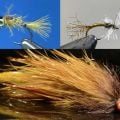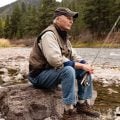How to Tip Fishing Guides and Lodges
A STORY I like to tell about tipping involves a gentleman known among his friends, appropriately, as Wild Phil. Phil used to place a $100 bill in plain sight on the console of my skiff, and whenever he jumped a tarpon, he would get down and hand me the hundred dollars. One day, after we had jumped 9 tarpon in just a couple of hours, I was struck by the relative absurdity of this relationship, and I said, “Phil, you don’t need to be so generous.”
Phil thought about this for a few seconds, then said, “You’re right. I want you to know that I’m grateful. But I don’t want you to think I’m stupid.”
And so it is with tipping and fishing. Understand a little bit about how your guide, or lodge personnel, or captain are compensated and, within general expectations, follow your instincts.

photo by McNair Evans
General Guidelines
With the amount of traveling fly fishers do, it’s surprising that there aren’t well-publicized standards for tipping guides — something like the $1-to-$2 per bag “rule” for airport skycaps and hotel bellmen in the U.S. But just as guides and lodges in different parts of the world charge different rates for the same services, they can also have very different expectations of what makes a fair gratuity.
You may have some fixed rules of your own, like 15 percent for service people, or 20 percent if they’ve done an outstanding job. But following those rules in all foreign countries may do a disservice to other anglers and to lodge management. And what do you do at a lodge where half a dozen people are involved in ensuring the quality of your visit? Or maybe you’ve heard that in some parts of the world, T-shirts and fishing lures are more meaningful than cash. And what about that obnoxious bass guide in Florida who didn’t like fly fishers because he couldn’t tack on his normal “backlash” fee? (“Wind knot fees,” you suggested under your breath.)
The short answer to these questions is that tipping etiquette in the fly fishing business follows the same general rules that apply to all service industry workers in a given country. In the U.S. for example, gratuities of more than 20 percent mean you were extremely happy about the experience; tipping less than 10 percent means you were dissatisfied, but communicates to the service provider that you know tipping is customary.
In all cases, if you are using a booking service or know someone who has fished the location before, ask. You’ll avoid uncomfortable moments like a bartender in New Zealand refusing your $10 tip (“Why don’t you just buy a round for the bar, mate?”).
Is tipping discretionary? Tipping amounts — even in the U.S. and neighboring countries, where gratuities are often taken for granted — should always reflect quality of service. But not tipping in an industry where gratuities make up a considerable portion of the incomes of the lower-paid staff is almost always insulting. Discussing the source of a bad experience with a lodge manager while you are on-site, for example, is far better than leaving without tipping.
Guidelines for Tipping Independent Guides
First, let’s clarify what we mean by “independent guide.” Florida skiff guides and light-tackle offshore guides, New England and California striper guides, Texas bass and coastal redfish guides, and trout, salmon and steelhead guides not part of a lodge setting — whether booked by an outfitter or not — should all be considered independent guides, as far as tipping is concerned. What sets them apart is that they generally run their operations and provide service individually, absorbing the attendant overhead, and if they do accept bookings from a retail shop or outfitter, they generally have to pay a commission for that service.
If you are budgeting for gratuities, figure in 15 percent for an average level of service from an independent fly fishing guide, but not less than 10 percent. Guides get a large percentage of their income from tips. Some top-tier guides expect a sizeable tip, and won’t find future openings in their schedule for new clients who don’t tip 20 percent. And regularly tipping more than 15 percent can get you access to peak-season slots that suddenly “come open.”
Of course if a guide makes an exceptional effort — fishing an extra hour or three beyond the norm or working especially hard to put you on fish — tipping well makes good sense. Being stingy after a remarkable effort punishes the guide and the anglers who follow you. Not happy and don’t plan to fish with the same guide again? It’s still a good idea to tip something, even if it’s only 5 percent — it’s not worth saving a few bucks and risking having it become known among the other guides that you don’t tip.
One somewhat special case worth mentioning regards tipping independent Bahamas and other independent foreign guides. It’s hard to know what to tip independent foreign guides because in many cases their rates are considerably lower than independent guides in the U.S. As a rule, you should plan on tipping $40-50 to a bonefish guide for day of work in the Bahamas or around the Caribbean and Central and South America. In Iceland, on the other hand, you should plan to tip a salmon guide $50-100 per day.
 All that being said, keep in mind that many of the best guides in the U.S. would fish with their favorite customers even if they never tipped. When I was guiding — especially in the early years when I had little choice over my clientele — I believed that there was no amount of money that could compensate me for the pain of dealing with lousy customers. But I would have guided my best clients for free; tips from them were the icing. Here are a couple of other non-monetary suggestions for treating your guide well and letting them know you appreciate their efforts:
All that being said, keep in mind that many of the best guides in the U.S. would fish with their favorite customers even if they never tipped. When I was guiding — especially in the early years when I had little choice over my clientele — I believed that there was no amount of money that could compensate me for the pain of dealing with lousy customers. But I would have guided my best clients for free; tips from them were the icing. Here are a couple of other non-monetary suggestions for treating your guide well and letting them know you appreciate their efforts:
- Show up 5-10 minutes early. Don’t make your guide wait, especially early in the morning.
- Be pleasant company and fish well. Can’t fish well? You can try hard, and that’s all a good guide expects. Don’t get angry or frustrated to the point where it is interfering with the experience. Don’t talk on your cell phone while tarpon are sipping crabs from the surface 20 feet in front of the boat. And don’t strip all of your backing onto the floor of your guide’s rig on the way to the river.
- Don’t treat taking your guide out to dinner as part of the gratuity. Most hardworking guides consider the opportunity to spend precious evening hours with their clients part of their work day, not a bonus.
Gratuities at Destination Fishing Lodges and on Package Trips
Unlike with independent guides, there are many variations on the accepted standards for tipping at lodges and on package trips, so gather as much information as you can before arriving. Every booking agent we know says that questions about tipping are the most common inquiry they get from traveling anglers, so if they don’t include the information in their trip “ready list,” be sure to ask for it.
General guidelines for tipping at lodges include the following:
Count on an extra 7-12 percent of the total package cost (on the land package, not including taxes, travel and other non-destination service charges), carried either as cash in your carry-on bag, which is best, or in the form of personal checks or travelers’ checks (note that travelers’ checks are one of the least-favored forms of gratuity, since banks will often charge significant fees to have them deposited; it’s a sore spot with guides, especially in far-flung locations). Suggestions for total tips will range from 5 percent to 15 percent, however, depending on your booking agent, the destination, and the total package price, so be sure to ask the agent or the lodge manager. Don’t let anyone convince you that you will be expected to pay more than 7-8 percent in gratuities on an $8000 trip. And just in case you were curious, 60-70 percent of these tips typically end up with the guides, and the rest is distributed to the non-guiding staff.
More often than not, you will be better off leaving a “collective” gratuity for your entire stay with the lodge manager at the end of the trip than you will tipping service staff and guides individually. The reasons for this are not readily apparent, but they include the fact that overtipping to individuals makes it more difficult for the lodge manager to control the expectations (and behavior) of the staff. At some lodges, guides who have been tipped excessively muscle out the less-experienced or less-senior but perhaps more-talented guides for access to the high tippers. And at other lodges, direct tipping throws a huge wrench into the works. For example, at Christmas Island, which became a very popular Pacific Ocean bonefishing destination in the 1980s, the local culture did not consider tipping to be acceptable behavior [note: this is also still true among other Pacific island cultures, including the newly publicized fishery at Penrhyn Atoll]. It wasn’t until arriving international anglers influenced the local guides that individual tipping became part of the experience. Finally, you many not always realize who is working the hardest to make your trip enjoyable. The camp cook, for example, may be getting up an hour before everyone else and going to bed an hour later, and working twice as hard during the day as the average guide.
If you do want to tip a guide working from a lodge operation directly, a $40-60 tip per day is the norm, at least in Alaska. (Be sure not to wait until the end of the week to reward your guide.) And in those rare cases where your guide is also flying you out to your day’s fishing, it is worth an additional $10 or $20. Generally, though, you can assume your pilot is getting a share of the lodge tip.
Cash rules, no matter where you go. Some lodges accept credit cards, but many don’t. And as we’ve already hinted, travelers’ checks are often worth 10-20 percent less than their face value after being cashed by the local bank and can be an inconvenience for guides. If you feel unsafe traveling with cash, find out what other form of payment the managers at your destination prefer. Note that in some special cases, however, cash tips to guides are discouraged — in parts of the Amazon for example, guides at some lodges I’ve visited were notorious for spending their tips on alcohol and not showing up for work for a week — and a lodge manager may suggest that you gift items like T-shirts or fishing lures instead of cash. Rarely should non-monetary gifts be counted as part of your overall gratuity, however, unless you have made a special pre-arrangement with your independent guide.
Tipping for Offshore and Other Special Types of Angling Excursions
There are also special types of destination angling that follow different sets of rules when it comes to gratuities. These include fishing from larger offshore boats, typically when fly fishing for billfish, whether they are directly booked or set up by a local lodge. (Note: we are not talking here about single-crew, open-fisherman type operations, where independent guide rules apply.)
In most parts of the world, you should expect to tip both the captain and mate(s) of an offshore boat independently of the lodge tip. The average gratuity for most operations works out to around $50 for the captain and $25 for each crew member for the entire boat, whether there are four anglers or only one. Some lodges and crews will expect higher gratuities, especially if they specialize in destination angling, but the most you should reasonably expect to tip a boat captain and crew collectively is $150 per day. Obviously, the crew and captain both have to work harder with a full boat, so consideration should be made if you are splitting the gratuity. As always, and especially when arranging for offshore fishing through a lodge, get a clear answer from the lodge or booking agent about tipping expectations.
Often in the Caribbean, South America, Central America and Mexico, you will find opportunities to fish with guides working independently out of small boats like pangas. These guides typically charge less and expect less in the way of tips than guides in established guiding communities, so let common sense be your guide, but be wary of over-tipping. Oftentimes these guides are not familiar with fly fishing techniques, expect to catch and sell their fish, and are used to smaller gratuities.
Finally, there are a few other special situations and customs you should be aware of:
- In some parts of Latin America, such as Venezuela and parts of Mexico, and in some European countries like France and Italy, gratuities are automatically added to restaurant and/or hotel bills. Be sure to know the customs so that you can avoid double-tipping.
- As in the example mentioned at the beginning of this article, service personnel in Australia and New Zealand and bartenders in the U. K. generally find tipping strange, as do people in Germany, Japan and China. That doesn’t mean that you shouldn’t plan on tipping guides and lodges in countries where gratuities are uncommon, however. Although New Zealanders, for example, aren’t all accustomed to tipping, guests regularly tip at most of the fly fishing lodges there — usually $100-200 for a week’s stay, considerably less than the 7-10% that could be considered average at a U.S. lodge.
The most important thing to know about tipping is that a little knowledge goes a long way. Don’t agonize about what is fair. Be excessive if the spirit of the occasion warrants it. And remember that a small tip sometimes sends a stronger message than no tip at all.











